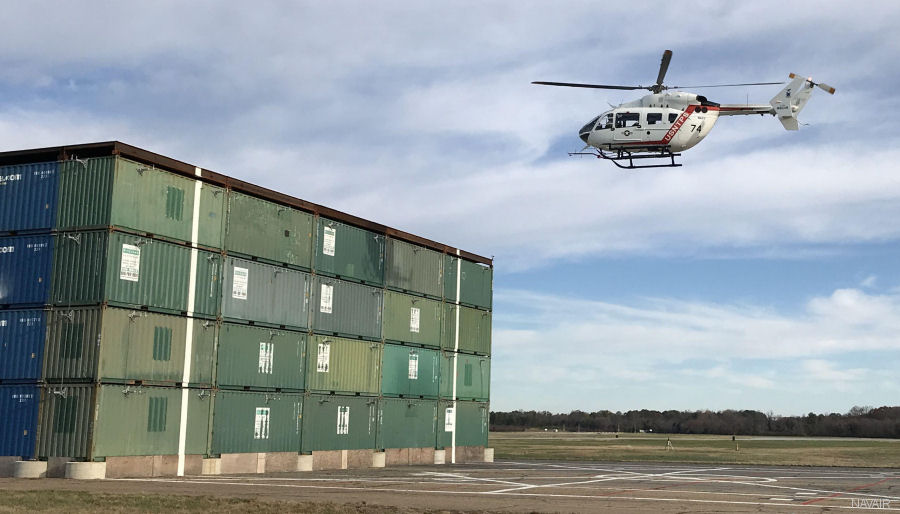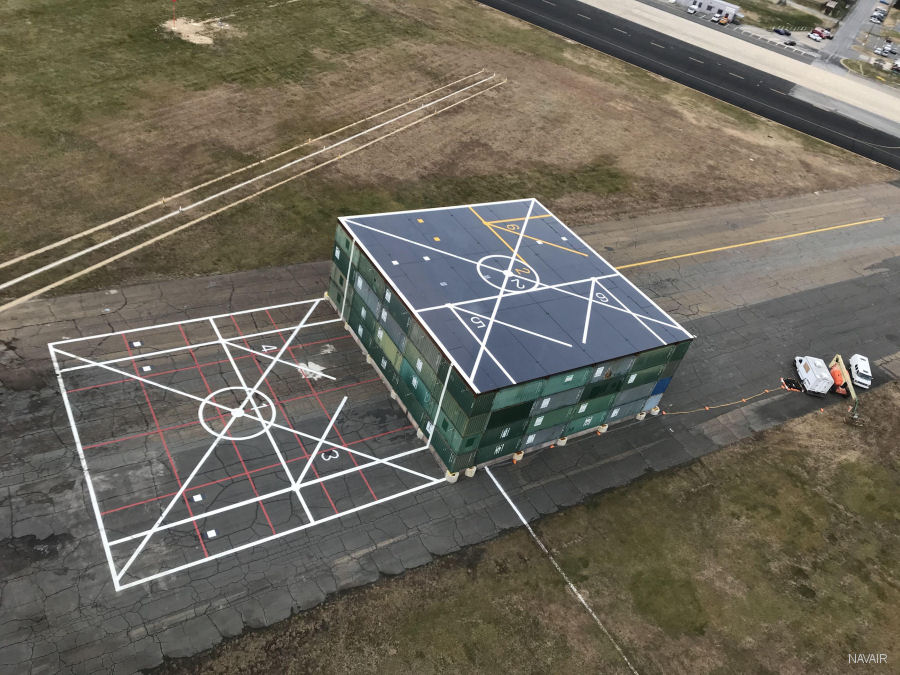
Less widely known, but no less valuable, is their dedication to conducting original research that broadens the body of aerospace knowledge and improves flight test safety and practice.
A good example of this is a recent flight test program conducted by USNTPS rotary wing instructors John Tritschler and John Holder to evaluate the hover performance of helicopters near obstacles and inside confined areas, in order to better understand how helicopters behave when landing on and taking off from ships at sea, rooftop platforms, and other complex environments.
Helicopter rotors generate lift in part by accelerating air downward — a phenomenon, appropriately enough, called downwash. Nearby obstacles such as buildings, hangars, and ship superstructures can bounce some of that downwash back toward the helicopter, which is called recirculation. Excessive recirculation can force a pilot to use more engine power to stay in a hover, and in some extreme instances it can even result in a loss of control. It's a situation that pilots learn to deal with through experience, but Tritschler and Holder sought to gain a more systematic understanding of downwash recirculation so that pilots could train better to deal with it.
"We have been conducting flight test research programs for several years at USNTPS," Tritschler said. "This particular project came about organically from a previous project that Noddy" — that's Holder's call sign from his previous service in the Royal Navy — "and I conducted to assess the effect of sloping terrain on helicopter downwash."
To conduct their research program, Holder and Tritschler took advantage of a unique opportunity: a temporary structure that had been built on a disused taxiway at NAS Patuxent River. Constructed from over 100 shipping containers stacked to form a 38-foot-tall box and capped with steel plates, the Elevated Fixed Platform (EFP) was built to test recirculation effects on the V-22 Osprey using dozens of anemometers affixed to the sides of the EFP to measure airflow variations. Once those tests were completed, the two USNTPS instructors learned, there would be a brief window of time before the EFP was dismantled. It was an opportunity they couldn't pass up.
"I saw the EFP as a target of opportunity for USNTPS," Tritschler said. "I argued that it would have been irresponsible of us as a learning institution not to take advantage of this great opportunity to create a dataset that would be useful not just for the engineering community, but also for the operational community."
With the approval of USNTPS commanding officer Lt. Col. Rory Feely, Holder and Tritschler developed and implemented a series of test flights with three USNTPS helicopters — a UH-72A Lakota, a UH-60L Black Hawk, and an OH-58C Kiowa — to study how recirculation affected the helicopters' performance when hovering at various predetermined locations and altitudes above and alongside the EFP's roof, walls, and corners. Once the roof and one wall have been removed as part of the dismantling process, the two pilots will return to fly a similar series of tests inside the box itself. So far, five USNTPS staff pilots have participated in the research flights along with Holder and Tritschler, providing them with valuable first-hand experience and knowledge that they can use in designing test projects of their own.
During the tests, Holder and Tritschler varied the helicopters' rotor speeds and gross weight. "In doing so, you get a wide range of thrust conditions, and you can explore whether there are any sensitivities that effect those conditions," Tritschler explained. "We wanted to make sure that we collected data across the widest range as possible because it is inappropriate to draw conclusions on vehicle performance on the basis of extrapolated data."
Once the test flights are completed at the end of February, the two instructors will analyze the data they collected to see what patterns emerge. "We're going to let the data indicate to us just how well the phenomena we observed can be generalized for helicopters with a single main rotor," Tritschler said. "Then, hopefully we can make broader statements to a wide range of operational communities about how much additional power margin they will need in a given operational scenario. But at this point, it's an open question just how much the results will generalize across aircraft."
Validate computational fluid dynamics models
Naval Air Warfare Center Aircraft Division engineers will also be able to use the data collected in this investigation to validate the computational fluid dynamics models they are developing as part of the Dynamic Interface Virtual Environment (DIVE) program. Led by NAWCAD engineers and funded by the Office of Naval Research, the DIVE program seeks to develop simulations that will enable designers and operators to reduce the amount of shipboard testing required to establish launch and recovery envelopes for rotary wing aircraft.
Tritschler said that USNTPS has some unique advantages that enable it to conduct this type of fundamental research, namely a variety of rotary wing aircraft on strength and the in-house expertise needed to prepare and execute a rigorous, highly repeatable test plan.
USNTPS commanding officer Lt. Col. Rory Feely said that original research like Holder's and Tritschler's helps keep the school in the forefront of aeronautical research through partnerships with agencies like NASA and the Federal Aviation Administration, as well as supports the Navy’s other research efforts into aircraft shipboard landing characteristics. And by allowing instructors to engage in career pursuits that extend beyond the classroom, it plays a vital workforce development role for the school too.
“The academics walk to the aircraft every day,” Feely said. “How else do you get to be the preeminent flight test school unless you allow people to indulge their curiosity and explore important questions and use their imagination and skills to push boundaries? It’s a philosophy that has enabled USNTPS to become a brain trust of aviation.”
The research conducted by USNTPS instructors also benefits the pilots, engineers, and Naval Flight Officers who attend the school as students. "As an institution, you don't want to teach the same thing over and over again because then you'll stagnate," Tritschler said. "Knowledge isn't finite. Research allows us to think deeply about the most important elements of flight test as well as performance and handling qualities that we wouldn't be able to do elsewhere."
"You don't want to just teach what is known," Tritschler emphasized. "If you don't start exploring the unknown, you start losing that edge."

See also |
USNTPS
UH-72A Lakota in
ONR




